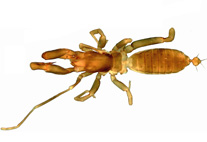Abstract
The genus Dendrocephalus Daday, 1908 consists of 17 described species. The morphology of the frontal appendage and the first pairs of thoracopods of males are the main characteristics used for species identification. The objectives of this study were to increase knowledge of the morphology of Dendrocephalus orientalis and to propose a new identification key for the species occurring in Brazil. Specimens were collected in temporary ponds within the conservation unit Monument Natural Grota do Angico (MNGA), which straddles the borders of the municipalities of Poço Redondo and Canindé de São Francisco, State of Sergipe, Brazil. During the study period, 560 male individuals of D. orientalis were sampled. The specimens showed variations in the number of spines on the eyes and the proximal surface of the male frontal appendage. On the eye, the number of spines ranged from 0 to 2; morphotypes with 1 and 2 spines predominated in the samples, with 50.5% and 46.2%, respectively. The number of spines on each eye was the same within each individual. On the proximal surface of the males frontal appendage the following numbers of spines on each arm were recorded: 1 and 1 (57.86%); 2 and 1 (30.89%); 2 and 2 (9.46%); 1 and 0 (1.25%); 3 and 2 (0.36%); 2 and 0 (0.18%). Based on these variations, we conclude that the number of spines on the eyes and the frontal appendage arms cannot be used as a diagnostic character for species identification. On the other hand, the first pairs of thoracopods and sub-branches 1V and 2A of the frontal appendage should be included in keys, since these structures did not show significant intraspecific morphological variation.

